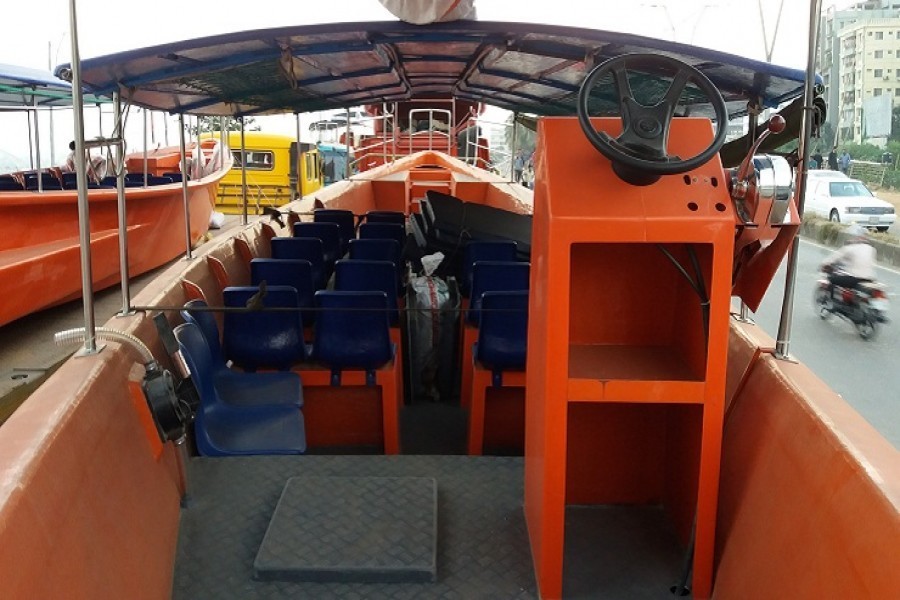Years back the launching of circular waterbus service around the capital did strike a note of hope for many. No doubt, the idea of using the rivers surrounding Dhaka and its adjoining areas was well received from all quarters as a means of easing commuting and removing pressure on the city's road traffic. But since the launch in 2004, the project hit snags in various phases to the extent of being almost abandoned. Lately, it has been learnt that the authorities are revisiting the project plan in an attempt to make things better.
Originally, the plan was to launch waterbus in five rivers -- Buriganga, Dhaleshwari, Balu, Turag and Shitalakshya -- surrounding Dhaka. As a pilot project, waterbus service was introduced by Bangladesh Inland Water Transport Corporation (BIWTC) on a 29-kilometre Gabtoli-Badamtoli route. But soon after, the project turned into a non-starter bumping into problems that the implementing agency should have sorted out well ahead of the launch. River pollution and lack of navigability were the immediate problems that had the project stuck in difficulties which could not be remedied. Besides, unplanned setting of the jetties disregarding the convenience of the passengers, particularly absence of road links between the jetties and the city in most cases was too serious a deterrent to keep the project afloat. It is beyond comprehension how the authorities went for running the project without attending to these extremely vital issues. Media reports say the Gabtoli-Badamtoli service had been incurring operating losses to the tune of Tk 40,000 a day on the route until the authorities shut the losing service.
It must not be denied that on paper the project looked grand and so materialising it successfully was sure to bring a great respite for the commuters. Clearly, all it needed was designing an appropriate plan and putting in place necessary facilitations that among others included smooth navigability of the water vessels, freeing the waters from pollution and developing necessary infrastructure. The sad part of the project is that it was revived twice since 2004 but hardly with any serious effort to address the problems that kept it non-functional.
The failure of the service was attributed to a number of reasons. First of all, the speed of the small launches could not be made faster due to obstructions created by shallow underwater land patches. During winter, the water buses had to cut down on their operations drastically. Many others had to change their routes in order to move along those having the required depth. This would delay the travel time that most passengers could not keep up with. The longer-than-usual commuting eventually prompted the passengers to return to the age-old bus journey, except during monsoon.
Clearly, the decision taken up by the government was not backed by required homework. The concerned authorities should have conducted an in-depth survey of the routes, take note of the problems and redress those, at least up to a certain satisfactory level before launching the service. It seems all they thought important was procuring some water transports. Observers feel that rather than doing alone, that too hurriedly, the authorities should have consulted experts.
Now that the authorities are mulling to relaunch the project, it is not understood if they are prepared to redress the wrongs, and if so, how soon. As a viable alternative to road travel, the waterbus service must in the first place be passenger-friendly-- in that it has to be affordable, less time consuming with other accompanying facilities like road links from the jetties to the city. Navigability in all seasons, particularly in the winter, must be ensured through necessary dredging. Observers feel sitting on such a useful project for so long without any progress speaks volumes for utter inefficiency and wastefulness. This is most undesirable at a time when the government is going to roll out mega schemes like the metro rail, Padma bridge, elevated expressway--- all to ease movement.
Experts and observers are of the opinion that there are at least three problems that must be addressed to make the circular water bus project functional. These are: lack of navigability, pollution of river waters and low-height bridges on a number of river channels that obstruct movement of river transports. Recently, the government is set to launch a 20-year river master plan which includes these issues as priority works to be done in phases. The master plan may go as planned; however, as an immediate recourse to re-launching the water bus service, it is important that some short-term work plan is taken up so that part of the problems may be mitigated, and the project can hopefully be in a better position than now.
The water bus project is a shocker to many and the unfortunate part is the little attention it received from the authorities concerned despite being recognised as a highly promising one.


